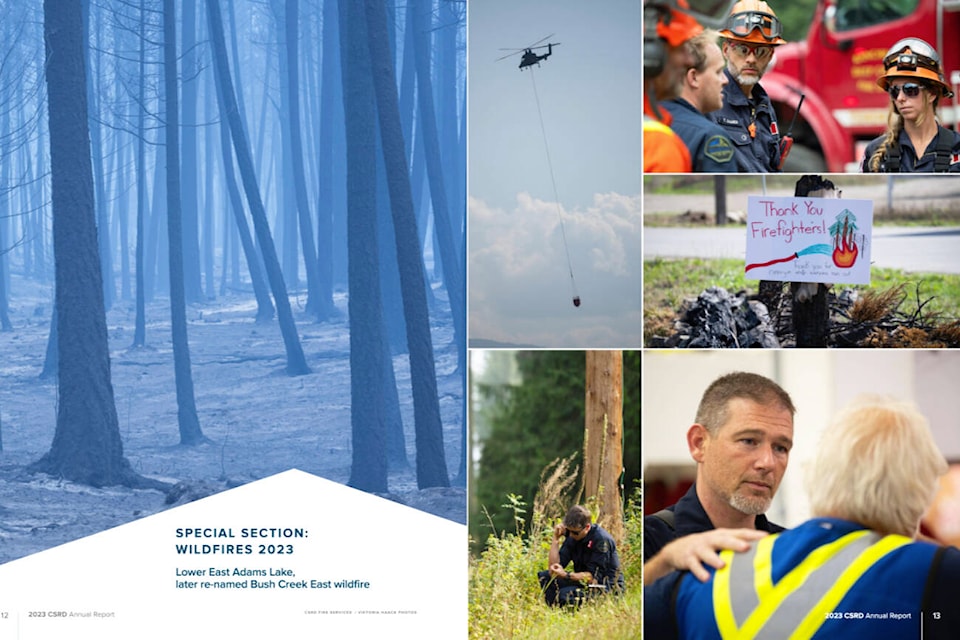By Barb Brouwer
Contributor
Challenge and change.
These are the words that captured Columbia Shuswap Regional District chair Kevin Flynn’s assessment of 2023 in his introduction to the regional district’s annual report, which was introduced at the May 16 board meeting in Golden.
The biggest challenge of 2023 was the huge Bush Creek East wildfire that destroyed 176 structures within the CSRD, and damaged more than 50 others. More than 8,000 people were evacuated from Electoral Areas F and G, but thankfully there was no loss of life.
“My list of those deserving of gratitude would likely be as large as this publication and I would like to commend our Emergency Operations Centre staff and the CSRD and BC Wildfire Service firefighters, including those who came from as far as Ontario, Saskatchewan, Yukon, Australia, South Africa, Brazil, Mexico, Costa Rica and the United States,” wrote Flynn. “Special thanks need to be extended to our Emergency Support Service volunteers for donating their time and skills to help evacuees.”
In a much more positive vein, Flynn remarked on the progress that has been made on the Shuswap North Okanagan Rail Trail thanks to continued work by the CSRD, Splatsin and the Regional District of North Okanagan.
John MacLean was introduced as the new chief administrative officer and, with the board, began a process of organizational restructuring within the CSRD to enhance efficiency and productivity. That effort is continuing into 2024 with the development of a new strategic plan.
MacLean echoed Flynn’s comments, pointing out the CSRD delivers more than 119 different services to approximately 57,000 residents in four municipalities and seven electoral areas.
“We provide programs and services that protect and enhance the social fabric of our communities, conduct operations in consideration of the local environment and contribute to crucial infrastructure in the region,” noted MacLean. “Among other things, the CSRD operates landfills and recycling, provides emergency support services, enhances tourism, coordinates parks, plans for land use, enforces bylaws, supplies fire protection and manages water systems.”
Such was the enormity of the 2023 wildfires that the annual report contains a special section providing an overview that includes a response timeline (July 12 to Sept. 23) of the Lower East Adams Lake wildfire, later renamed Bush Creek East wildfire after the two fires merged.
The special section also highlights the role of the Emergency Operations Centre where workers logged 5,600 hours, and the Emergency Support Services where 49 trained volunteers contributed more than 3,600 hours.
While wildfire teams came from across the globe, more than 150 structural firefighters from the CSRD’s 13 fire departments provided both structure protection and wildland/urban interface firefighting.
At the height of the fire, crews worked 24-7 to protect homes in the North Shuswap and Sorrento from suffering further loss. It was exhausting, difficult, hot and dirty work.
“Some of our firefighters lost their own homes to this blaze but continued their work to try and protect other homes,” noted CSRD Fire Chief Sean Coubrough. “That is truly what being a firefighter is about – putting others before yourself and working to protect the safety of all.”
Read more: 4 Shuswap firefighters head north to help battle wildfires
Read more: Columbia-Shuswap officials call for review of B.C.’s wildfire response
Also critically important were the services provided by CSRD Information Technology staff who worked diligently to keep systems set up and running in the Emergency Operations Centre and Emergency Reception Centres for evacuees. CSRD Environmental and Utility Services staff worked to develop programs to deal with the disposal of 1,300 fridges and freezers, along with spoiled food products due to power loss in the area.
Other EOC staff worked hard to provide critically important information to the public within a flood of misinformation being spread through social media.
Begun in the fall of 2023, recovery efforts will be a long process and efforts to support the affected areas will continue into 2024 and beyond.
While the wildfires of 2023 cannot be downplayed, CSRD board and staff continued to work on projects and issues across the vast 28,886 square metre region 57,021 people call home.
The annual report contains information on organizational structure and the services CSRD provides to 24,595 household in seven electoral areas and four municipalities.
CSRD communications coordinator Tracy Hughes drew rave reviews from several directors for the wealth and quality of information presented in a clear and easily digestible way.
The full report is available at csrd.bc.ca.
